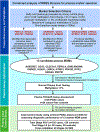High Detection Rates of Pancreatic Cancer Across Stages by Plasma Assay of Novel Methylated DNA Markers and CA19-9
- PMID: 33593879
- PMCID: PMC8102343
- DOI: 10.1158/1078-0432.CCR-20-0235
High Detection Rates of Pancreatic Cancer Across Stages by Plasma Assay of Novel Methylated DNA Markers and CA19-9
Abstract
Purpose: We have previously identified tissue methylated DNA markers (MDMs) associated with pancreatic ductal adenocarcinoma (PDAC). In this case-control study, we aimed to assess the diagnostic performance of plasma MDMs for PDAC.
Experimental design: Thirteen MDMs (GRIN2D, CD1D, ZNF781, FER1L4, RYR2, CLEC11A, AK055957, LRRC4, GH05J042948, HOXA1, PRKCB, SHISA9, and NTRK3) were identified on the basis of selection criteria applied to results of prior tissue experiments and assays were optimized in plasma. Next, 340 plasma samples (170 PDAC cases and 170 controls) were assayed using target enrichment long-probe quantitative amplified signal method. Initially, 120 advanced-stage PDAC cases and 120 healthy controls were used to train a prediction algorithm at 97.5% specificity using random forest modeling. Subsequently, the locked algorithm derived from the training set was applied to an independent blinded test set of 50 early-stage PDAC cases and 50 controls. Finally, data from all 340 patients were combined, and cross-validated.
Results: The cross-validated area under the receiver operating characteristic curve (AUC) for the training set was 0.93 (0.89-0.96) for the MDM panel alone, 0.91 (95% confidence interval, 0.87-0.96) for carbohydrate antigen 19-9 (CA19-9) alone, and 0.99 (0.98-1) for the combined MDM-CA19-9 panel. In the test set of early-stage PDAC, the AUC for MDMs alone was 0.84 (0.76-0.92), CA19-9 alone was 0.87 (0.79-0.94), and combined MDM-CA19-9 panel was 0.90 (0.84-0.97) significantly better compared with either MDMs alone or CA19-9 alone (P = 0.0382 and 0.0490, respectively). At a preset specificity of 97.5%, the sensitivity for the combined panel in the test set was 80% (28%-99%) for stage I disease and 82% (68%-92%) for stage II disease. Using the combined datasets, the cross-validated AUC was 0.9 (0.86-0.94) for the MDM panel alone and 0.89 for CA19-9 alone (0.84-0.93) versus 0.97 (0.94-0.99) for the combined MDM-CA19-9 panel (P ≤ 0.0001). Overall, cross-validated sensitivity of MDM-CA19-9 panel was 92% (83%-98%), with an observed specificity of 92% at the preset specificity of 97.5%.
Conclusions: Plasma MDMs in combination with CA19-9 detect PDAC with significantly higher accuracy compared with either biomarker individually.
©2021 American Association for Cancer Research.
Conflict of interest statement
Figures




Similar articles
-
Multimodal Pancreatic Cancer Detection Using Methylated DNA Biomarkers in Pancreatic Juice and Plasma CA 19-9: A Prospective Multicenter Study.Clin Gastroenterol Hepatol. 2025 Apr;23(5):766-775. doi: 10.1016/j.cgh.2024.07.048. Epub 2024 Oct 28. Clin Gastroenterol Hepatol. 2025. PMID: 39477082
-
Validation of four candidate pancreatic cancer serological biomarkers that improve the performance of CA19.9.BMC Cancer. 2013 Sep 3;13:404. doi: 10.1186/1471-2407-13-404. BMC Cancer. 2013. PMID: 24007603 Free PMC article.
-
Sequential Validation of Blood-Based Protein Biomarker Candidates for Early-Stage Pancreatic Cancer.J Natl Cancer Inst. 2017 Apr 1;109(4):djw266. doi: 10.1093/jnci/djw266. J Natl Cancer Inst. 2017. PMID: 28376157 Free PMC article.
-
Diagnostic Accuracy of Blood-based Biomarkers for Pancreatic Cancer: A Systematic Review and Meta-analysis.Cancer Res Commun. 2022 Oct 20;2(10):1229-1243. doi: 10.1158/2767-9764.CRC-22-0190. eCollection 2022 Oct. Cancer Res Commun. 2022. PMID: 36969742 Free PMC article.
-
Diagnostic value of serum carbohydrate antigen 19-9 in pancreatic cancer: a systematic review and meta-analysis.Eur J Gastroenterol Hepatol. 2022 Sep 1;34(9):891-904. doi: 10.1097/MEG.0000000000002415. Epub 2022 Jul 27. Eur J Gastroenterol Hepatol. 2022. PMID: 35913776
Cited by
-
Improving the prognosis of pancreatic cancer: insights from epidemiology, genomic alterations, and therapeutic challenges.Front Med. 2023 Dec;17(6):1135-1169. doi: 10.1007/s11684-023-1050-6. Epub 2023 Dec 27. Front Med. 2023. PMID: 38151666 Review.
-
Novel diagnostic biomarkers for pancreatic cancer: assessing methylation status with epigenetic-specific peptide nucleic acid and KRAS mutation in cell-free DNA.Front Oncol. 2024 Jul 5;14:1395473. doi: 10.3389/fonc.2024.1395473. eCollection 2024. Front Oncol. 2024. PMID: 39035743 Free PMC article.
-
Plasma Methylated DNA Markers for Melanoma Surveillance.JCO Precis Oncol. 2023 Sep;7:e2300389. doi: 10.1200/PO.23.00389. JCO Precis Oncol. 2023. PMID: 37883729 Free PMC article.
-
Diagnosing and monitoring pancreatic cancer through cell-free DNA methylation: progress and prospects.Biomark Res. 2023 Oct 5;11(1):88. doi: 10.1186/s40364-023-00528-y. Biomark Res. 2023. PMID: 37798621 Free PMC article. Review.
-
Discovery and Validation of Methylated DNA Markers From Pancreatic Neuroendocrine Tumors.Gastro Hep Adv. 2022 Apr 2;1(3):409-416. doi: 10.1016/j.gastha.2022.01.006. eCollection 2022. Gastro Hep Adv. 2022. PMID: 39131680 Free PMC article.
References
-
- Siegel RL, Miller KD, Jemal A. Cancer statistics, 2018. CA: a cancer journal for clinicians. 2018;68:7–30. - PubMed
-
- Ishikawa O, Ohigashi H, Imaoka S, Nakaizumi A, Uehara H, Kitamura T, et al. Minute carcinoma of the pancreas measuring 1 cm or less in diameter--collective review of Japanese case reports. Hepato-gastroenterology. 1999;46:8–15. - PubMed
-
- Siegel RL, Miller KD, Jemal A. Cancer statistics, 2019. CA: a cancer journal for clinicians. 2019;69:7–34. - PubMed
-
- Owens DK, Davidson KW, Krist AH, Barry MJ, Cabana M, Caughey AB, et al. Screening for Pancreatic Cancer: US Preventive Services Task Force Reaffirmation Recommendation Statement. Jama. 2019;322:438–44. - PubMed
Publication types
MeSH terms
Substances
Grants and funding
LinkOut - more resources
Full Text Sources
Other Literature Sources
Medical
Miscellaneous

